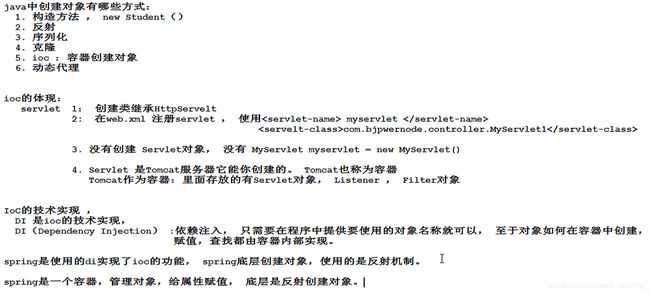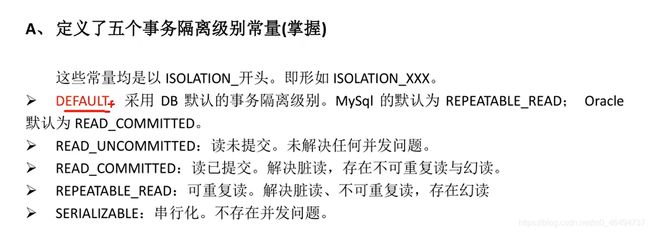万字Spring框架学习总结(附核心代码详细注释)
Spring学习笔记总结
学习视频地址:动力节点视频
1.Spring概述
1.1Spring框架是什么?
Spring框架是一个开放源代码的J2EE应用程序框架,由[Rod Johnson](https://baike.baidu.com/item/Rod Johnson/1423612)发起,是针对bean的生命周期进行管理的轻量级容器(lightweight container)。 Spring解决了开发者在J2EE开发中遇到的许多常见的问题,提供了功能强大IOC、AOP及Web MVC等功能。Spring可以单独应用于构筑应用程序,也可以和Struts、Webwork、Tapestry等众多Web框架组合使用,并且可以与 Swing等桌面应用程序AP组合。因此, Spring不仅仅能应用于J2EE应用程序之中,也可以应用于桌面应用程序以及小应用程序之中。Spring框架主要由七部分组成,分别是 Spring Core、 Spring AOP、 Spring ORM、 Spring DAO、Spring Context、 Spring Web和 Spring Web MVC。
- spring全家桶: spring ,springmvc,spring boot,spring cloud
- spring:出现是在2002左右,解决企业开发的难度。减轻对项目模块之间的管理,类和类之间的管理,帮 助开发人员创建对象,管理对象之间的关系。spring核心技术ioc ,aop。能实现模块之间,类之间的解耦合。
1.2Spring的优点
-
轻量
spring框架使用的jar比较小,都在1M一下或者几百kb。spring核心功能的所需的jar总共在3M左右。spring框架运行时占用的资源少,运行效率高,不依赖别的jar。
-
针对接口编程,解耦合
spring提供了Ioc控制反转,由容器管理对象,对象的依赖关系。原来在程序代码中的对象创建方式,现状由容器完成。对象之间的依赖解耦合。
-
AOP编程的支持
通过Spring提供的AOP功能,方便进行面向切面的编程,许多不容易用传统0OP实现的功能可以通过AOP轻松应付,在Spring中,开发人员可以从繁杂的事务管理代码中解脱出来,通过声明式方式灵活地进行事务的管理,提高开发效率和质量。
-
方便集成各种优秀的框架
Spring不排斥各种优秀的开源框架,相反Spring可以降低各种框架的使用难度,Spring提供了对各种优秀框架( 如Struts,Hibernate、MyBatis) 等的直接支持。简化框架的使用。Spring像插线板一样, 其他框架是插头,可以容易的组合到一起。需要使用哪个框架,就把这个插头放入插线板。不需要可以轻易的移除。
1.3Spring的体系结构
2.Ioc控制反转
控制反转(Ioc,Inversion of Control),是一个概念,一种思想。指将传统上由程序代码直接操控的对象调用权交给容器,通过容器来实现对象的装配和管理。控制反转就是对对象控制权的转移,从程序代码本身反转到了外部容器。通过容器实现对象的创建,属性赋值,依赖的管理。
IoC是一个概念,是一种思想,其实现方式多种多样。当前比较流行的实现方式是依赖注入。应用广泛。
依赖: classA 类中含有classB的实例,在classA中调用classB的方法完成功能,即classA对classB有依赖。
loc的实现:
➢依赖注入: DI(Dependency Injection),程序代码不做定位查询,这些工作由容器自行完成。
依赖注入DI是指程序运行过程中,若需要调用另一个对象协助时,无须在代码中创建被调用者,而是依赖于外部容器,由外部容器创建后传递给程序。
Spring的依赖注入对调用者与被调用者几乎没有任何要求,完全支持对象之间依赖关系的管理。
Spring框架使用依赖注入(DI) 实现IoC。
Spring容器是一个超级大工厂,负责创建、管理所有的Java对象,这些Java对象被称为Bean。Spring 容器管理着容器中Bean之间的依赖关系,Spring 使用“依赖注入”的方式来管理Bean之间的依赖关系。使用loC实现对象之间的解耦合。
2.1开发工具准备
利用maven工具,创建
实现步骤:
1.创建maven项目
2.加入maven的依赖
spring的依赖,版本5.3.7
junit依赖
3.创建类(接口和它的实现类),和没有使用框架一样,就是普通的类。
4.创建spring需要使用的配置文件
声明类的信息。这些类由spring创建和管理
5.测试spring创建的对象。
2.2Sprig的第一个程序
<beans xmlns="http://www.springframework.org/schema/beans"
xmlns:xsi="http://www.w3.org/2001/XMLSchema-instance"
xsi:schemaLocation="http://www.springframework.org/schema/beans
http://www.springframework.org/schema/beans/spring-beans.xsd">
<bean id="someService" class="cqutlc.service.Impl.someServiceImpl">bean>
<bean id="mydate" class="java.util.Date"/>
beans>
package cqutlc;
import cqutlc.service.Impl.someServiceImpl;
import cqutlc.service.someService;
import org.junit.Test;
import org.springframework.context.ApplicationContext;
import org.springframework.context.support.ClassPathXmlApplicationContext;
public class Test1 {
@Test
public void test1(){
someService someService=new someServiceImpl();
someService.doSome();
}
/*spring默认创建对象的时间:在创建spring的容器时,他会创建配置文件中的所有对象*/
@Test
public void test2(){
//使用spring容器创建的对象
//1.指定spring配置文件的名称
String config="beans.xml";
//2.创建表示spring容器的对象,ApplicationContext
//ClassPathXmlApplicationContext;表示从类路径中加载spring的配置文件
ApplicationContext ac=new ClassPathXmlApplicationContext(config);
//3.从容器中获取某个对象,你要调用对象的方法,
//getBean("配置文件中的bena的id值");
someService service=(someService)ac.getBean("someService");
//使用spring创建好的对象
service.doSome();
}
/*获取spring容器中的Java对象的信息*/
@Test
public void test3(){
String config="beans.xml";
ApplicationContext ac=new ClassPathXmlApplicationContext(config);
//使用spring提供的方法,获取容器中定义的对象的数量
int num=ac.getBeanDefinitionCount();
System.out.println(num);
//容器中每个定义的对象的名称
String[] names= ac.getBeanDefinitionNames();
for (String name : names) {
System.out.println(name);
}
}
}
2.3基于XML的DI
在spring配置文件中,给Java对象的属性赋值。
di:依赖注入,表示创建对象,给属性赋值。
di的实现语法:
1.在spring配置文件中,使用标签和属性完成,叫做基于xml的di实现
2.使用spring中的注解进行属性的赋值,叫做基于注解的di实现。
di的语法分类
1.set注入(设置注入): spring调用类的set方法,在set方法可以实现属性的赋值
2.构造注入,spring调用类的有参构造方法,创建对象。在构造方法中完成赋值。
set注入实例分析
<beans xmlns="http://www.springframework.org/schema/beans"
xmlns:xsi="http://www.w3.org/2001/XMLSchema-instance"
xsi:schemaLocation="http://www.springframework.org/schema/beans http://www.springframework.org/schema/beans/spring-beans.xsd">
<bean id="student" class="cqutlc.ba01.Student">
<property name="name" value="李四"/>
<property name="age" value="20"/>认准set方法
bean>
beans>
当属性为引用类型时
2.引用类型的set注入:spring调用set方法
-->
<bean id="student" class="cqutlc.ba02.Student">
<property name="name" value="李四"/>
<property name="age" value="24"/>
<property name="school" ref="school"/>
bean>
<bean id="school" class="cqutlc.ba02.School">
<property name="name" value="cqut"/>
<property name="address" value="cq"/>
bean>
构造注入
得有构造参数
2.构造注入 spring调用类的有参数构造方法,在创建对象的同时给属性赋值
构造注入使用
-->
<bean id="student" class="cqutlc.ba03.Student">
<constructor-arg name="name" value="lc"/>
<constructor-arg name="age" value="19"/>
<constructor-arg name="school" ref="myschool"/>
bean>
<bean id="myschool" class="cqutlc.ba03.School">
<property name="name" value="cqut"/>
<property name="address" value="cq"/>
bean>
引用类型的自动注入
byName和byType
<beans xmlns="http://www.springframework.org/schema/beans"
xmlns:xsi="http://www.w3.org/2001/XMLSchema-instance"
xsi:schemaLocation="http://www.springframework.org/schema/beans http://www.springframework.org/schema/beans/spring-beans.xsd">
<bean id="student" class="cqutlc.ba04.Student" autowire="byName">
<property name="name" value="李四"/>
<property name="age" value="24"/>
bean>
<bean id="school" class="cqutlc.ba04.School">
<property name="name" value="cqut"/>
<property name="address" value="cq"/>
bean>
beans>
多个配置文件的优势
1.每个文件的大小比一个文件要小得多。效率高
2.避免多人竞争带来的冲突
多文件的分配方式:
1.按功能模块,一个模块一个配置文件。
2.按类的功能,数据库相关,做事务处理的,做service的。
包含关系的配置路径
2.4基于注解的DI
通过注解完成Java对象的创建,属性赋值
使用注解的步骤
-
加入maven的依赖spring-context,在你加入spring-context的同时,间接加入spring-aop的依赖。
使用注解必须使用spring-aop依赖
-
在类中加入spring的注解(多个不同功能的注解)
-
在spring的配置文件中,加入一个组件扫描器的标签,说明注解在你的项目中的位置。
学习的注解有:
1.@Component 2.@Repository 3.@Service 4.@Controller 5.@Value 6.@Autowired 7.@Resource
简单类型
<beans xmlns="http://www.springframework.org/schema/beans"
xmlns:xsi="http://www.w3.org/2001/XMLSchema-instance"
xmlns:context="http://www.springframework.org/schema/context"
xsi:schemaLocation="http://www.springframework.org/schema/beans http://www.springframework.org/schema/beans/spring-beans.xsd http://www.springframework.org/schema/context https://www.springframework.org/schema/context/spring-context.xsd">
<context:component-scan base-package="cqutlc.ba01"/>
beans>
package cqutlc.ba01;
import org.springframework.stereotype.Component;
/*
* @Component:创建对象的,等同于的功能
* 属性value: 就是对象的名称,也就是bean的id值,value值是唯一的,创建的对象在整个spring容器中就一个
* 位置:在类的上面写注解
* */
//等同于package cqutlc;
import cqutlc.ba01.Student;
import org.junit.Test;
import org.springframework.context.ApplicationContext;
import org.springframework.context.support.ClassPathXmlApplicationContext;
public class test1 {
@Test
public void test(){
String config="applicationContext.xml";
ApplicationContext ac=new ClassPathXmlApplicationContext (config);
//从容器中获取对象
Student student=(Student) ac.getBean ("student");
System.out.println (student);
}
}
* spring中和@Component功能一致,创建对象的注解还有:
* @Repository(用在持久层上):放在dao的实现类上面,
* 表示创建dao对象,dao对象是能访问数据库的。(持久层注解)
*
* @Service(用在业务层类的上面):放在service的实现类上面,
* 创建service对象,service对象是做业务处理的,可以有事物等功能的。
*
* @Controller(用在控制器的上面):放在控制器(处理器)类的上面,创建控制器对象的,
* 控制器对象可以接收用户提交的参数和显示请求的处理结果。
*
* 以上三个注解的使用语法和@Component是一样的,都能够创建对象,但是这三个注解还有额外的功能----给项目分层
指定多个包的三种方式
- 使用多次组件扫描器标签,指定不同的包
- 使用分隔符(分号或者逗号)分隔多个包名
- 指定父包
引用类型
@Autowired:spring框架提供的注解,实现引用类型的赋值
spring中通过注解给引用类型赋值,使用的是自动注入,支持byName和byType
@Autowired默认使用@byType自动注入
位置:1.在属性定义的上面,无需set方法,推荐使用。被引用的类必须提前利用@Component注解标识。
2.在set方法的上面
属性:required,是一个boolean类型的,默认是true,表示引用类型失败时,程序报错并终止运行。要是false则正常运行,赋值为null
最好用true,可以及时发现错误!
如果要使用byName的方式
1.在属性的上面加上@Autowired
2.在属性上面加入@Qualifier(vlaue=“bean的id”):表示使用指定名字的bean完成赋值。
@Resource:来自于JDK中的注解,spring框架提供了对这个注解功能的支持。可以用它给引用类型赋值,使用的也是自动注入原理,支持byName,byType。默认是byName
位置:
1.在属性定义的上面,无需set方法,推荐使用
2.在set方法的上面 先使用byName自动注入,假如失败了就会再使用byType
如何只使用byName?
需要新增加一个属性name name的值为bean的id名称
3.AOP面向切面编程
3.1动态代理
动态代理是指:程序在整个运行过程中根本就不存在目标类的代理类,目标对象的代理只是由代理生成工具(不是真实定义的类)在程序运行时由JVM根据反射等机制动态生成,代理对象与目标对象的代理关系在程序运行时确定。
实现方式:
jdk动态代理, 使用jdk中的Proxy, Method, Invocai tonHanderl创建代理对象。jdk动态代理要求目标类必须实现接口。
cglib动态代理:第三方的工具库,创建代理对象,原理是继承。通过继承目标类,创建子类。子类就是代理对象。要求目标类不能是final的,方法也不能是final的。
动态代理的作用:
- 在目标类源代码不变的情况下,增强功能
- 减少代码的重复
- 专注业务逻辑代码
- 解耦合,让你的业务功能和日志,事务非事务功能分离
3.2AOP简介
AOP (Aspect Orient Programming),面向切面编程。面向切面编程是从动态角度考虑程序运行过程。
AOP底层,就是采用动态代理模式实现的。采用了两种代理: JDK的动态代理,与CGLIB的动态代理。
AOP为Aspect Oriented Programming的缩写,意为:面向切面编程,可通过运行期动态代理实现程序功能的统一维护的一种技术。AOP是Spring框架中的一个重要内容。利用AOP可以对业务逻辑的各个部分进行隔离,从而使得业务逻辑各部分之间的耦合度降低,提高程序的可重用性,同时提高了开发的效率。(动态代理的规范化,把动态代理的实现步骤,方式都定义好了,让开发人员用一种统一的方法,使用动态代理)。
切面:给你的目标类增加的功能,就是切面,什么日志等(切面的特点:一般都是非业务方法,独立使用的。)
面向切面编程,就是将交叉业务逻辑封装成切面,利用AOP容器的功能将切面织入到主业务逻辑中。所谓交叉业务逻辑是指,通用的、与主业务逻辑无关的代码,如安全检查、事务、日志、缓存等。
若不使用AOP,则会出现代码纠缠,即交叉业务逻辑与主业务逻辑混合在一起。这样,会使主业务逻辑变的混杂不清。
如何理解面向切面编程?
- 需要在分析项目功能时,找出切面。
- 合理的安排切面的执行时间(在目标方法前呢,还是后呢)
- 合理的安全切面执行位置,在哪个类,哪个方法增加增强
3.3AOP编程术语
- Aspect:切面,表示增强的功能,就是一堆代码,完成某个功能。(非业务功能,可独立执行。如:日志,统计信息,权限验证等)
- JoinPoint:连接点,连接你的业务方法和切面位置。其实就是某个类中的业务方法。
- Pointcut:切入点,指多个连接点方法的集合。
- 目标对象:给哪个类的方法增加功能,这个类就是目标对象。
- Advice:通知,通知表示切面功能执行的时间。
一个切面有三个关键的要素:
- 切面的功能代码,切面干什么
- 切面的执行位置,使用Pointcut表示切面执行位置
- 切面执行时间,使用advice表示时间。
3.4AspectJ对AOP的实现
aop的实现
aop是一个规范,是一个动态的一个规范化,一个标准。
aop的技术实现框架:
1.spring:spring在内部实现了aop规范,能做aop的工作。
2.aspectJ:一个开源的专门做aop的框架。spring框架中集成了aspectJ框架,通过spring就可以使用aspectJ的功能了。
aspectJ框架实现有两种方式:1.使用xml的配置文件(配置全局事务) 2.使用注解,一般都用注解
3.5学习AspectJ框架的使用
如何表示切面的执行时间?
注解表示:1.@Before 2.@AfterReturning 3.@Around 4.@AfterThrowing 5.@After
如何表示切面执行的位置?
使用的是切入点表达式。
表达式原型为:
execution(modifiers-pattern? ret-type-pattern
declaring-type-pattern?name-pattern(param-pattern)
throws-pattern?)
解释:
modifiers-pattern 访问权限类型
ret-type-pattern 返回值类型
declaring-type-pattern 包名类名
name-pattern(param-pattern) 方法名(参数类型和参数个数)
throws-pattern 抛出异常类型
?表示可选部分
以上表达式共分为四个部分 execution(访问权限 方法返回值 方法声明(参数)异常类型)
切入点表达式要匹配的对象就是目标方法的方法名。所以,execution 表达式中明显就是方法的签名。注意,表达式中黑色文字表示可省略部分,各部分间用空格分开。在其中可以使用以下符号:
Aspect的开发环境
使用aspectJ框架实现aop
使用aop:目的是给已经存在的一些类和方法,增加额外的功能,前提是不改变原来的类的代码。
框架的使用步骤:
1.新建maven项目
2.加入依赖
spring依赖 aspectJ依赖 junit单元测试
3.创建目标类:接口和他的实现类
要做的是给类中的方法去增加功能
4.创建切面类:普通类
1.在类的上面加入@Aspect
2.在类中去定义方法---要执行的功能代码
3.在方法的上面加入aspectJ中的通知注解,例如@Before
还需要指定切入点表达式execution()
5.创建spring的配置文件,在文件中声明对象,把对象交给容器统一管理
声明对象可以使用注解或者xml配置文件
声明目标对象
声明切面类对象
声明aspectJ框架中的自动代理生成器标签(用来完成代理对象的自动创建功能的)
6.创建测试类,从spring容器中获取目标对象(实际上是代理对象)。
通过代理执行方法,实现aop的功能增强
@Before实现的一个例子
package cqutlc.ba01;
public interface SomeSevice {
void doSome(String name,Integer age);
}
package cqutlc.ba01;
//目标类
public class SomeSeviceImpl implements SomeSevice {
@Override
public void doSome (String name, Integer age) {
//给doSome方法增加一个功能,在doSome方法执行之前,输出方法的执行时间
System.out.println ("目标方法执行");
}
}
package cqutlc.ba01;
import org.aspectj.lang.annotation.Aspect;
import org.aspectj.lang.annotation.Before;
import java.util.Date;
/*
*
@Aspect:aspectJ框架中的注解,用来表示当前类是切面类
* 位置:类定义的上面
* */
@Aspect
public class MyAspect {
/*
* 定义方法:实现切面功能的、
* 方法的定义要求:
* 1.公共方法
* 2.没有返回值3.方法名自定义4.方法可以有参数也可以没有参数,有几个参数类型可以使用()
* */
/*@Before 前置通知注解
* 属性:value,切入点表达式,表示切面的功能执行的位置
* 特点:在目标方法之前先执行,不会改变目标方法的执行结果,不会影响目标方法的执行
* */
@Before (value = "execution(public void *..SomeSeviceImpl.doSome(..))")
public void myBefore(){
//功能代码
System.out.println ("时间:"+new Date ());
}
}
<beans xmlns="http://www.springframework.org/schema/beans"
xmlns:xsi="http://www.w3.org/2001/XMLSchema-instance" xmlns:aop="http://www.springframework.org/schema/aop"
xsi:schemaLocation="http://www.springframework.org/schema/beans http://www.springframework.org/schema/beans/spring-beans.xsd http://www.springframework.org/schema/aop https://www.springframework.org/schema/aop/spring-aop.xsd">
<bean id="someService" class="cqutlc.ba01.SomeSeviceImpl"/>
<bean id="myAspect" class="cqutlc.ba01.MyAspect"/>
<aop:aspectj-autoproxy/>
beans>
package cqutlc.ba01;
import org.junit.Test;
import org.springframework.context.ApplicationContext;
import org.springframework.context.support.ClassPathXmlApplicationContext;
public class test1 {
@Test
public void test1(){
String config="applicationContext.xml";
ApplicationContext ac=new ClassPathXmlApplicationContext (config);
SomeSevice proxy=(SomeSevice)ac.getBean ("someService");
//通过代理的对象执行方法,实现目标方法执行时,增强了功能。
proxy.doSome ("lisi",20);
}
}
JoinPoint
指定通知方法中的参数
joinpoint:业务方法,要加入切面功能的业务方法
作用是:可以在通知方法中获取方法执行时的信息,例如,方法名称,方法的实参。
如果你的切面功能中需要用到方法的信息,就加入joinpoint
这个joinpoint参数的值是由框架赋予,必须是第一个位置的参数。
@Aspect
public class MyAspect {
@Before (value = "execution(public void *..SomeSeviceImpl.doSome(..))")
public void myBefore(JoinPoint jp){
//获取方法的完整定义
System.out.println("方法的定义:"+jp.getSignature());
System.out.println("方法的名称:"+jp.getSignature().getName());
//获取方法的实参
Object[] args= jp.getArgs();
for(Object arg: args){
System.out.println("参数="+arg);
}
//功能代码
System.out.println ("时间:"+new Date ());
}
}
@AfterReturning
package cqutlc.ba02;
import org.aspectj.lang.JoinPoint;
import org.aspectj.lang.annotation.AfterReturning;
import org.aspectj.lang.annotation.Aspect;
import org.aspectj.lang.annotation.Before;
import java.util.Date;
/*
*
@Aspect:aspectJ框架中的注解,用来表示当前类是切面类
* 位置:类定义的上面
* */
@Aspect
public class MyAspect {
/*
* 后置通知定义方法:实现切面功能的、
* 方法的定义要求:
* 1.公共方法
* 2.没有返回值3.方法名自定义4.方法有参数,推荐使用object,参数名自定义
* */
/*
* @AfterReturning
* 属性:
* 1.value:切入点表达式
* 2.returning:自定义的变量,用来表示目标方法的返回值,自定义变量名必须和通知方法的形参名一样
* 特点:
* 1.在目标方法之后执行的
* 2.能够获得目标方法的返回值,可以根据这个返回值做不同的处理功能
* Object res = doOther();
* 3.可以修改这个返回值。
* */
@AfterReturning(value = "execution(* *..SomeSeviceImpl.doOther(..))",
returning = "res")
public void myAfterReturing(Object res){
//Object res :是目标方法执行后的返回值,根据返回值做你的切面的功能处理
System.out.println ("后置通知,获取的返回值是"+res);
if (res.equals ("abc")){
res="hi";
}else
{
}
}
}
@Around环绕通知-增强方法有ProceedingJoinPoint参数
package cqutlc.ba03;
import org.aspectj.lang.JoinPoint;
import org.aspectj.lang.ProceedingJoinPoint;
import org.aspectj.lang.annotation.Around;
import org.aspectj.lang.annotation.Aspect;
import org.aspectj.lang.annotation.Before;
import java.util.Date;
/*
*
@Aspect:aspectJ框架中的注解,用来表示当前类是切面类
* 位置:类定义的上面
* */
@Aspect
public class MyAspect {
/*
* 环绕通知定义方法的格式
* 1.public
* 2.有一个返回值 object
* 3.方法名称自定义
* 4.方法有参数,固定的 ProceedingJoinPoint
*
* */
/*@Around
特点:
1.功能最强的通知
2.在目标方法前和后都可以加入功能
3.控制目标方法是否被调用实行
4.修改原来的目标方法的执行结果,影响最后的调用结果
环绕通知等同于jdk动态代理,InvocationHandler接口
参数:ProceedingJoinPoint 就等同于Method
作用:执行目标方法的执行结果,可以被修改。
环绕通知:经常做事务,在目标方法之前开启事务,执行目标方法,在目标方法之后提交事务
* */
@Around (value = "execution(* *..SomeServiceImpl.doFirst(..))")
public Object myAround(ProceedingJoinPoint pjp) throws Throwable {
String name="";
Object[] args =pjp.getArgs ();
if (args!=null&&args.length>1){
Object arg= args[0];
name=(String)arg;
}
//在目标方法前或者后加功能
//实现环绕通知
Object result=null;
System.out.println ("环绕通知在目标方法之前"+new Date ());
if ("zhangsan".equals (name)){
//1.实现目标方法的调用
result= pjp.proceed ();//method.invoke,object result=doFirst();
}
System.out.println ("环绕通知在目标方法之后,提交事务");
return result;
}
}
package cqutlc.ba03;
import org.junit.Test;
import org.springframework.context.ApplicationContext;
import org.springframework.context.support.ClassPathXmlApplicationContext;
public class test1 {
@Test
public void test1(){
String config="applicationContext.xml";
ApplicationContext ac=new ClassPathXmlApplicationContext (config);
SomeService proxy=(SomeService)ac.getBean ("someService");
String str=proxy.doFirst ("lc",19);
}
}
@Pointcut定义切入点
当较多的通知增强方法使用相同的execution切入点表达式时,编写、维护均较为麻烦。
AspectJ提供了@Pointcut注解,用于定义execution切入点表达式。其用法是,将@Pointcut注解在一个方法之上,以后所有的execution的value属性值均可使用该方法名作为切入点。代表的就是@Pointcut定义的切入点。这个使用@Pointcut注解的方法一般使用private 的标识方法,即没有实际作用的方法。
属性 :value切入点表达式
位置:自定义的方法的上面
特点:当使用@Pointcut定义在一个方法的上面,此时这个方法的名称就是切入点表达式的别名,其他的通知中,value属性就可以使用这个方法名称代替切入点表达式。
@Pointcut(value="execution(* *..SomeServiceImpl.doOther(..))")
private void mypt(){
//无需代码
}
有接口也可以使用cglib代理
在xml中配置
4.Spring集成MyBatis
把mybatis和spring框架集成在一起,像一个框架一样使用。
用的技术是:IOC
为什么ioc能把spring和mybatis集成在一起?是因为ioc能创建对象,可以把mybatis创建的对象交给spring统一创建,开发人员从spring中获取对象。开发人员不用同时面对两个或多个框架了,就面对一个spring就行了。
mybatis使用步骤
我们会使用独立的连接池类替换掉mybatis中自带的连接池,把连接池类也交给spring创建
spring需要创建的对象有:
- 独立的连接池类的对象,使用阿里的druid连接池
- SqlSessionFactory对象
- 创建dao对象
spring和mybatis集成
步骤
1.新建maven项目
2.加入依赖 spring依赖 mybatis依赖 mysql驱动 spring的事务依赖 mybatis和spring集成的依赖(SqlSessionFactory)
3.创建实体类
4.创建dao接口和mapper文件
5.创建mybatis主配置文件
6.创建service接口和实现类,属性是dao
7.创建spring的配置文件:声明mybatis的对象交给spring创建
1.数据源 dataSource
2.SqlSessionFactory
3.Dao对象
4.声明自定义的service
8.创建测试类,获取service对象,通过service调用dao完成数据库的访问
spring配置文件:
<beans xmlns="http://www.springframework.org/schema/beans"
xmlns:xsi="http://www.w3.org/2001/XMLSchema-instance"
xsi:schemaLocation="http://www.springframework.org/schema/beans http://www.springframework.org/schema/beans/spring-beans.xsd">
<bean id="myDataSource" class="com.alibaba.druid.pool.DruidDataSource"
init-method="init" destroy-method="close">
<property name="url" value="jdbc:mysql://localhost:3306/MySql
?useUnicode=true&characterEncoding=utf8&serverTimezone=GMT"/>
<property name="username" value="root"/>
<property name="password" value="131138"/>
<property name="maxActive" value="20"/>
bean>
<bean id="sqlSessionFactory" class="org.mybatis.spring.SqlSessionFactoryBean">
<property name="dataSource" ref="myDataSource"/>
<property name="configLocation" value="classpath:mybatis.xml"/>
bean>
<bean class="org.mybatis.spring.mapper.MapperScannerConfigurer">
<property name="sqlSessionFactoryBeanName" value="sqlSessionFactory"/>
<property name="basePackage" value="cqutlc.dao"/>
bean>
<bean id="studentService" class="cqutlc.service.Impl.StudentServiceImpl">
<property name="studentDao" ref="studentDao"/>
bean>
beans>
mybatis配置文件:
DOCTYPE configuration
PUBLIC "-//mybatis.org//DTD Config 3.0//EN"
"http://mybatis.org/dtd/mybatis-3-config.dtd">
<configuration>
<settings>
<setting name="logImpl" value="STDOUT_LOGGING"/>
settings>
<typeAliases>
<package name="cqutlc.domain"/>
typeAliases>
<mappers>
<package name="cqutlc.dao"/>
mappers>
configuration>
测试下:
package cqutlc;
import cqutlc.dao.studentDao;
import cqutlc.domain.Student;
import cqutlc.service.Impl.StudentServiceImpl;
import cqutlc.service.StudentService;
import org.junit.Test;
import org.springframework.context.ApplicationContext;
import org.springframework.context.support.ClassPathXmlApplicationContext;
import java.util.List;
public class test1 {
@Test
public void test(){
String config="applicationContext.xml";
ApplicationContext ac=new ClassPathXmlApplicationContext (config);
//获取spring容器中dao对象
studentDao studentDao=(studentDao) ac.getBean ("studentDao");
Student student=new Student (1005,"lc","[email protected]",20);
int nums=studentDao.insertStudent (student);
//spring和mybatis整合在一起使用,事务是自动提交的,无需执行SqlSession.commit();
System.out.println (nums);
}
@Test
public void test2(){
String config="applicationContext.xml";
ApplicationContext ac=new ClassPathXmlApplicationContext (config);
StudentService studentService=(StudentService) ac.getBean ("studentService");
Student student=new Student (1006,"jkl","[email protected]",20);
int nums=studentService.addStudent (student);
System.out.println (nums);
}
@Test
public void test3(){
String config="applicationContext.xml";
ApplicationContext ac=new ClassPathXmlApplicationContext (config);
StudentService studentService=(StudentService) ac.getBean ("studentService");
List<Student> students =studentService.queryStudents ();
for (Student student : students) {
System.out.println (student);
}
}
}
5.Spring事务
5.1spring的事务管理
事务原本是数据库中的概念,在Dao层。但是一般情况下,需要将事务提升到业务层,即Service层。这样做是为了能够使用事务的特性来管理具体的业务。
5.2spring事务管理API
事务的超时时间:表示一个方法的最长执行时间,如果方法执行时超过时间,就进行事务回滚。
单位:秒,整数,默认-1
事务的传播行为
控制业务方法是否有事务,有的话是什么样的事务。
7个传播行为:表示你的业务方法调用时,事务在方法之间是如何使用的。
PROPAGATION_REQUIRED:指定的方法必须在事务内执行,若当前存在事务,就加入到当前事务中,若当前没有事务,则创建一个新事务。这种传播行为是最常见的选择,也是spring默认的事务传播行为。
PROPAGATION_REQUIRES_NEW:指定的方法支持当前事务,但若当前没有事务,也可以也非事务方式执行。
PROPAGATION_SUPPORTS:总是创建一个新事务,若当前存在事务,就将当前事务挂起,直到新事务执行完毕。
总结spring事务:
1.管理事务的是,事务管理和它的实现类
2.spring的事务是一个统一的模型。
指定要使用的事务管理器实现类,使用 bean
指定哪些类,哪些方法需要加入事务管理功能
指定方法需要的隔离级别和传播行为,超时。
5.3程序举例环境搭建
模拟一个销售系统
package cqutlc.service;
import cqutlc.dao.GoodsDao;
import cqutlc.dao.SaleDao;
import cqutlc.domain.Goods;
import cqutlc.domain.Sale;
import cqutlc.excep.NotEnoughException;
public class BuyGoodsServiceImpl implements BuyGoodsService {
private SaleDao saleDao;
private GoodsDao goodsDao;
public void setSaleDao (SaleDao saleDao) {
this.saleDao = saleDao;
}
public void setGoodsDao (GoodsDao goodsDao) {
this.goodsDao = goodsDao;
}
/**/
@Override
public void buy (Integer goodsId, Integer nums) {
System.out.println ("buy方法的开始");
//记录销售信息
Sale sale=new Sale ();
sale.setGid (goodsId);
sale.setNums (nums);
saleDao.insertSale (sale);
//更新库存
Goods goods=goodsDao.selectGoods (goodsId);
if (goods==null){
throw new NullPointerException ("编号是:"+goodsId+"商品不存在");
}else if(goods.getAmount ()<nums) {
//库存不足
throw new NotEnoughException("编号是:"+goodsId+"库存不足!");
}
Goods buyGoods=new Goods ();
buyGoods.setId (goodsId);
buyGoods.setAmount (nums);
goodsDao.updateGoods (buyGoods);
System.out.println ("buy方法的结束");
}
}
5.4使用spring的事务注解管理事务
两种处理事务的方法:
1.适合于中小项目使用的:注解方法
spring框架自己用aop实现给业务方法增加事务的功能,使用 @Transactional注解增加事务
使用@Transactional的步骤
1.需要声明事务管理器对象
2.开启事务注解驱动,告诉spring框架,我要使用注解的方式管理事务。
spring使用aop机制,创建@Transactional所在的类代理对象,给方法加入事务的功能。
spring给业务方法加入事务:在你的业务方法执行之前,先开启事务,在业务方法执行结束后提交或者回滚事务,使用aop的环绕通知
3.在方法上加入@Transactional
<bean id="transactionManager" class="org.springframework.jdbc.datasource.DataSourceTransactionManager">
<property name="dataSource" ref="myDataSource"/>
bean>
<tx:annotation-driven transaction-manager="transactionManager"/>
/*
* rollbackFor表示发生指定的异常一定回滚
* */
@Transactional(
propagation = Propagation.REQUIRED,
isolation = Isolation.DEFAULT,
readOnly = false,
rollbackFor = {
NullPointerException.class,NotEnoughException.class
}
)
@Override
....省略(同上
5.5使用AspectJ的AOP配置管理事务
适合大型项目,有很多的类,方法,需要大量的配置事务,使用aspectJ框架功能,在spring配置文件中声明类,方法需要的事务。这种方式业务方法和事务配置完全分离。
实现步骤:都是在xml配置文件中实现。
1.要使用的是aspectJ框架需要加入对应的依赖。
2.声明事务管理器对象
3.声明方法需要的事务类型(配置方法的事物属性【隔离级别,传播行为,超时】)
4.配置aop,哪些类需要创建代理。
6.Spring与Web
web项目中容器对象只需要创建一次,把容器对象放入到全局作用域ServletContext中。
怎么实现:
使用监听器,当全局作用域对象被创建时,创建容器存入ServletContext
监听器作用:
1.创建容器对象,执行ApplicationContext ac=new ClassPathXmlApplicationContext (config);
2.把容器对象放入到ServletContext,ServletContext.setAttribute(key,ac)
监听器可以自己创建也可以用框架写好的 ContextLoaderListener
web.xml文件的配置
<web-app xmlns="http://xmlns.jcp.org/xml/ns/javaee"
xmlns:xsi="http://www.w3.org/2001/XMLSchema-instance"
xsi:schemaLocation="http://xmlns.jcp.org/xml/ns/javaee http://xmlns.jcp.org/xml/ns/javaee/web-app_4_0.xsd"
version="4.0">
<servlet>
<servlet-name>RegisterServletservlet-name>
<servlet-class>cqutlc.controller.RegisterServletservlet-class>
servlet>
<servlet-mapping>
<servlet-name>RegisterServletservlet-name>
<url-pattern>/registerServleturl-pattern>
servlet-mapping>
<context-param>
<param-name>contextConfigLocationparam-name>
<param-value>classpath:spring.xmlparam-value>
context-param>
<listener>
<listener-class>org.springframework.web.context.ContextLoaderListenerlistener-class>
listener>
web-app>
spring配置文件
<beans xmlns="http://www.springframework.org/schema/beans"
xmlns:xsi="http://www.w3.org/2001/XMLSchema-instance"
xsi:schemaLocation="http://www.springframework.org/schema/beans http://www.springframework.org/schema/beans/spring-beans.xsd">
<bean id="myDataSource" class="com.alibaba.druid.pool.DruidDataSource"
init-method="init" destroy-method="close">
<property name="url" value="jdbc:mysql://localhost:3306/MySql
?useUnicode=true&characterEncoding=utf8&serverTimezone=GMT"/>
<property name="username" value="root"/>
<property name="password" value="131138"/>
<property name="maxActive" value="20"/>
bean>
<bean id="sqlSessionFactory" class="org.mybatis.spring.SqlSessionFactoryBean">
<property name="dataSource" ref="myDataSource"/>
<property name="configLocation" value="classpath:mybatis.xml"/>
bean>
<bean class="org.mybatis.spring.mapper.MapperScannerConfigurer">
<property name="sqlSessionFactoryBeanName" value="sqlSessionFactory"/>
<property name="basePackage" value="cqutlc.dao"/>
bean>
<bean id="studentService" class="cqutlc.service.Impl.StudentServiceImpl">
<property name="studentDao" ref="studentDao"/>
bean>
beans>
RegisterServlet类
package cqutlc.controller;
import cqutlc.domain.Student;
import cqutlc.service.StudentService;
import org.springframework.context.ApplicationContext;
import org.springframework.context.support.ClassPathXmlApplicationContext;
import org.springframework.web.context.WebApplicationContext;
import org.springframework.web.context.support.WebApplicationContextUtils;
import javax.servlet.ServletContext;
import javax.servlet.ServletException;
import javax.servlet.http.HttpServlet;
import javax.servlet.http.HttpServletRequest;
import javax.servlet.http.HttpServletResponse;
import java.io.IOException;
public class RegisterServlet extends HttpServlet {
protected void doPost (HttpServletRequest request, HttpServletResponse response) throws ServletException, IOException {
request.setCharacterEncoding("UTF-8");
String strId=request.getParameter ("id");
String strName=request.getParameter ("name");
String strEmail=request.getParameter ("email");
String strAge=request.getParameter ("age");
//创建spring的容器对象
//String config="spring.xml";
//ApplicationContext ac=new ClassPathXmlApplicationContext (config);
/*WebApplicationContext ac=null;
//获取servletContext中的容器对象,创建好的容器对象,拿来就用
String key=WebApplicationContext.ROOT_WEB_APPLICATION_CONTEXT_ATTRIBUTE;
Object attr= getServletContext ().getAttribute (key);
if (attr!=null){
ac=(WebApplicationContext)attr;
}*/
WebApplicationContext ac=null;
ServletContext sc=getServletContext ();
ac=WebApplicationContextUtils.getRequiredWebApplicationContext (sc);
System.out.println ("容器对象的信息=="+ac);
//获取service
StudentService studentService=(StudentService) ac.getBean ("studentService");
Student student=new Student ();
student.setId (Integer.parseInt (strId));
student.setName (strName);
student.setEmail (strEmail);
student.setAge (Integer.parseInt (strAge));
studentService.addStudent (student);
//给一个结果页面
request.getRequestDispatcher ("/result.jsp").forward (request,response);
}
protected void doGet (HttpServletRequest request, HttpServletResponse response) throws ServletException, IOException {
}
}
protected void doGet (HttpServletRequest request, HttpServletResponse response) throws ServletException, IOException {
}
}
``
到这里就结束了,如果有什么疑问,欢迎评论,一起学习,一起进步O(∩_∩)O










